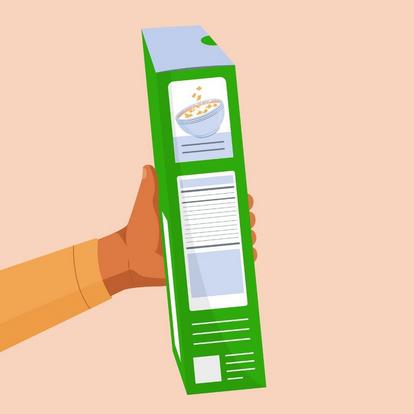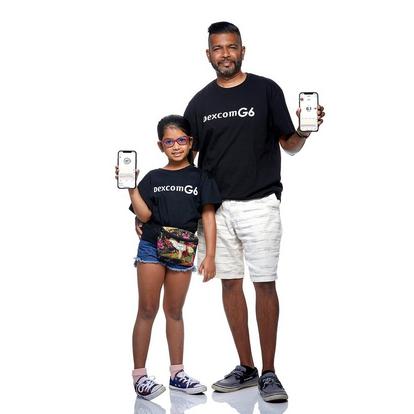The CGM Blog - Warrior Profile
How this Dad-Daughter Duo Manages Diabetes with Dexcom CGM
Courage, strength, and community define the diabetes experience for Dexcom Warriors Chloe Pow and her dad, Conrad. Chloe was diagnosed with type 1 diabetes (T1D) when she was just four years old. Since then, Chloe has become a confident advocate for diabetes education thanks to her bright spirit and Conrad’s passion for raising diabetes awareness.
For the Pows, the diabetes journey is as much about Chloe’s health as it is about helping others thrive. From walking the runway at Diabetes Canada’s Pump Couture fashion shows to mentoring other newly diagnosed kids, Chloe has found ways to turn her diagnosis into an opportunity for connection—and have a ton of fun along the way. Diabetes technology, including an insulin pump and a Dexcom Continuous Glucose Monitoring (CGM) System, has allowed Conrad to give Chloe more autonomy so that she can do what she loves while learning to manage T1D with greater independence.
Conrad’s approach to parenting Chloe has helped her—and the whole family—face her diagnosis with a positive attitude. Conrad believes that it’s his responsibility to reflect optimism and acceptance back to Chloe, giving her the tenacity to face the challenges of living with diabetes and transform those challenges into opportunities that enrich her life.
Adapting to a Diabetes Diagnosis
Conrad works at Diabetes Action Canada where he interacts closely with individuals living with diabetes and is involved with research initiatives. Even though he was familiar with the diabetes experience through his job, it wasn’t immediately apparent to him that Chloe was showing symptoms of T1D. Conrad and Chloe’s mom began to notice that she was urinating more often than normal and she had lost weight. Feeling concerned, Conrad asked a colleague who was a family doctor for advice. She gave him some glucose test strips to check if there was something going on with Chloe’s blood sugar levels.
Conrad had Chloe use the strips on Halloween day when she got home from school. “The test strip turned from light blue to dark brown. I called my boss to ask what it meant and she told me to go to the ER immediately,” Conrad remembers. At the hospital, Chloe was diagnosed with T1D.

“We’re going to take control of this, diabetes is not going to dictate Chloe’s life.”
Chloe was moved to a local children’s hospital where Conrad stayed with her for three days. “I remember going to the fridge on our floor that first night, and there was another dad there,” recalls Conrad. “We gave each other this nod. And that nod was so courageous. He was going through something and so were we. In that unspoken moment, I thought, ‘We’re going to take control of this, diabetes is not going to dictate her life.’”
Figuring Out Diabetes Management at School
After Chloe was diagnosed, the Pow family had to go through the process of getting a nurse assigned to her school who could test her blood sugar and administer insulin. Chloe needed seven insulin injections a day and, despite the discomfort, she quickly got used to the routine. During this transition, Conrad was looking for a way to more effectively monitor Chloe’s glucose so that they both had a little extra freedom to focus on their everyday lives at work and school.
Chloe began using Dexcom G5 after it was recommended by a participant at a diabetes research think tank Conrad was involved with. The Dexcom G5 allowed Conrad to monitor Chloe’s glucose levels remotely with the Dexcom Follow app.'* This gave him the peace of mind he needed to return to the office full-time, knowing that he could keep an eye on Chloe’s levels even when he wasn’t with her.

“With the remote monitoring, we could call the school and tell them to check so they could give her a snack or see when the nurse had given her insulin if she was going high.”
Using the Dexcom G5 gave Conrad a window into what was going on with Chloe’s glucose in the hours between when the nurse came to test her blood sugar, which only happened twice a day. “It turned out that she was going low every day during recess,” Conrad says. “With remote glucose monitoring, we could call the school and tell them to check so they could give her a snack or see when the nurse had given her insulin if she was going high.”
Chloe had to have insulin injections and wear her Dexcom sensor to school. Conrad wanted to make sure she didn’t experience any stigma from her classmates or teachers. He dropped into her class to answer questions about the condition. After Conrad’s visit to the school, Chloe’s classmates started to volunteer to go with her to the nurse’s office when she got her insulin injections throughout the day.
Building Confidence and Independence Around Diabetes Management
Chloe switched from the Dexcom G5 to Dexcom G6 in 2019 and is looking forward to trying out Dexcom G7. Getting Chloe a CGM system has enabled Conrad to teach her how to look after her glucose and manage diabetes on her own. “She knows that she needs to look at the back of the cereal box and measure out her carbs,” Conrad says. “She’s learning to check her glucose number before she eats and to make sure her phone is charged so that she can use the Dexcom app.”

“She knows that she needs to look at the back of the cereal box and measure out her carbs,” Conrad says. “She’s learning to check her glucose number before she eats and to make sure her phone is charged so that she can use the Dexcom app.”
Using CGM has allowed Conrad and Chloe to manage diabetes through all the new milestones in her life. Conrad feels confident enough to drop Chloe off at birthday parties and sleepovers instead of hanging around to make sure she’s okay. This gives Chloe the independence to simply enjoy being a kid with her friends. “Chloe can do anything. She can monitor herself now, anywhere she goes,” Conrad says. “She’s proactive, she brings snacks. She knows how to read all the numbers and arrows on her Dexcom app; it’s super intuitive, even for a kid.”

“Chloe can do anything. With Dexcom, she can monitor herself now, anywhere she goes. She knows how to read all the numbers and arrows on the app; it’s super intuitive, even for a kid.”
Chloe recently started running on the cross-country team. Conrad worried about whether they would be able to manage her glucose while she was exercising. “We were already at the course and about an hour before the meet, her glucose dropped below three,” Conrad says. “She had a granola bar and a juice box, and she was up and running.” With her glucose level stabilized, Chloe was able to compete and finished seventh out of 40 kids.
With Dexcom CGM Systems, Conrad doesn’t feel as much fear giving Chloe the freedom to do the things she loves to do. Looking after her glucose levels feels like a simple, routine part of life. “Dexcom provided a sense of empowerment,” Conrad says. “It’s like David and Goliath. You’re dealing with this disease, Goliath, but David has a trick up his sleeve— and that’s Dexcom.”
Transforming Adversity into Advocacy
Chloe and Conrad continue to raise awareness in school with yearly presentations about diabetes. On Chloe’s first “diaversary”—on Halloween, the year after her diagnosis—Chloe came up with the idea to attach information cards to the candy she was bringing to her class that day. The cards explained that T1D isn’t caused by eating too much sugar and listed some common symptoms. Conrad later learned that the information on the card helped a teacher in the school identify T1D symptoms in another student, potentially saving their life.
“Your child’s outlook on diabetes is going to mimic what your outlook is on diabetes.”
The experience had a profound impact on Chloe. She saw how powerful advocating for T1D awareness could be. Chloe is now a pen pal and mentor for other kids living with T1D, participating in video calls to help guide other children through putting on their first Dexcom sensor. Conrad set up a website, My T1D Journey, and launched a video series called How 2 Type 1 with Diabetes Canada to help families going through similar experiences. The dad and daughter duo are active in the diabetes community and are proud Dexcom Warriors.
It’s important to Conrad that he makes sure Chloe sees her diabetes as something that makes her special – kind of like a superpower - that can incite change and create connections. He calls Chloe his “Type One-der Woman” to remind her of how incredible she is. “Your child’s outlook on diabetes is going to mimic what your outlook is on diabetes,” Conrad says. “They’re in a new world and they’re relying on you to translate what the doctors and nurses are saying. If you can’t do that with a positive outlook, all your kid will pick up from is that something bad is going to happen and that a diagnosis is a terrible thing.”
Learn How Dexcom CGM Can Help Kids Living with Diabetes
Dexcom CGM systems, including Dexcom G6 and G7, are the only CGM systems approved for kids as young as two years old in Canada. Dexcom CGM can help young Warriors, like Chloe, to learn how to manage their glucose with confidence and a little extra independence. For children who may not feel the symptoms of high or low glucose levels, having a continuous glucose monitor that can alert them at certain thresholds when diabetes needs attention is especially critical. Parents of kids using Dexcom CGM Systems can monitor their child’s glucose remotely with the Dexcom Follow app* and get an in-depth view of glucose patterns. This can empower you and your child to take more proactive steps to maintain their glucose levels so they can feel their best as often as possible.
† Smart devices sold separately. For a list of compatible devices, please visit dexcom.com/compatibility.
*Requires the Follow App and an internet connection. Followers should always confirm readings on the Dexcom G6 CGM App before making treatment decisions.
*Requires the Follow App and an internet connection. Followers should always confirm readings on the Dexcom G6 CGM App before making treatment decisions.
